I have moved to a new wordpress address.
You can find it here: https://tobysinclairblog.wordpress.com/

I have moved to a new wordpress address.
You can find it here: https://tobysinclairblog.wordpress.com/

This year i’ve been on a journey of discovery into Coaching. My official job title is “Agile Coach” and as the title suggests a key part of the role is Coaching. This blog explores how i approach Coaching with the intention that my experience will help others interested in the topic.
This was a question that troubled me for many months. It’s not an easy question to answer. It’s something i’m still discovering but through constant reading and practice i’m much more informed than i was 12 months ago!
When someone asks me “What is Coaching?” i typically refer to this quote from the Inner Game of Tennis:
“Coaching is unlocking a persons potential to maximise their own performance.”
Timothy Gallwey
I like this quote because it really highlights that the Coaching focus is always on the Coachee.
In practical terms, Coaching is a conversation where the coach uses questioning to help the Coachee build awareness of how to tackle a goal or challenge.
In my experience the question “What is Coaching?” results in many different answers so it is important to address this question directly with the Coachee early on. This helps ensure there is a shared understanding within the relationship. I have often found that to begin with people think the process is similar to Mentoring. I’ve blogged recently the differences between Coaching and Mentoring.
Coaching conversations can happen any time. It doesn’t need to happen in a formal setting or in “official” coaching sessions. Don’t let this fool you through, Coaching is a structured practice that requires practice and continual improvement.
The types of Coaching i’ve done are:
Whilst i’m embedding more coaching into my daily interactions with people my journey really started with One-to-One Coaching sessions. These sessions provided a safe environment to learn. Let me explain further how Coaching works in these sessions.
When it comes to One-to-One Coaching sessions i generally have two types of engagement:
When i first started, rather than advertise my coaching services publicly I wanted to get some experience and practice. I spent time discussing with others my own personal goal to develop coaching experience. Eventually i found a a handful of people who were interested in being coached. I intentionally tried to find people that worked outside of my immediate influence, so not my direct team, and also people that i felt would be receptive of coaching. For the early sessions this felt like a safe environment to learn.
One of the most universally known Coaching models is “The GROW Model” and it was one of the first models i used too:
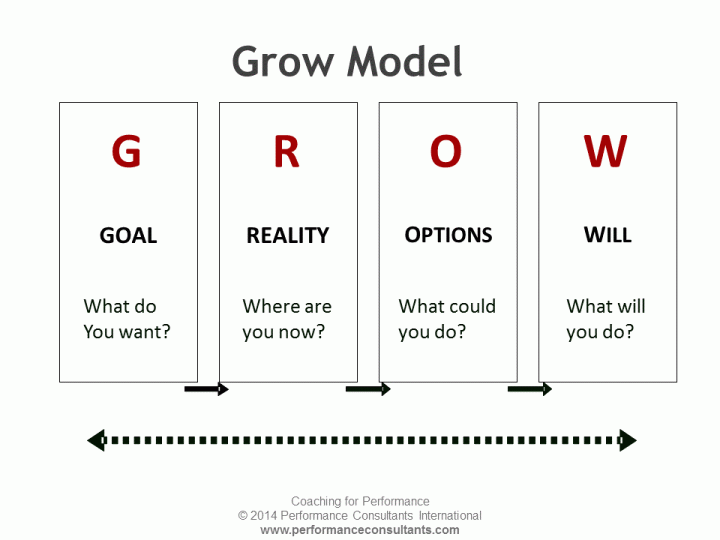
The GROW Model is a simple structure for a Coaching conversation. Personally i’ve found it incredibly useful as a mental model during the conversation to help give it structure. I also share this model with the Coachee so that it gives them a picture of how the conversation will be structured.
Whilst this is a good start, there is much more to learn. In my experience although the GROW model provides a good structure and its a great place to start, the more subtle skills are much harder to master. For example:
These topics are blog posts on their own but for now i’d recommend checking out the linked resources.
Since my early coaching sessions the number of people i’ve coached has broadened considerably. One of the fascinating benefits of coaching is the opportunity to work with people on a varied set of goals. Here are some examples (provided with consent):
Although these were the stated goals at the start of the coaching engagement often the Goal might become something else. For example, a Promotion is a good example of an end goal. During the coaching we may explore some related performance goals in the control of the Coachee that could contribute to the end goal.
In the above examples it’s important to be clear that the focus is to get the Coachee to a point where they are comfortable either their goal has been met or they have made enough progress that they are happy to continue their journey without the Coach. In the above examples the length of the coaching sessions ranged from 2 – 6 1hr sessions. This is in contrast to Mentoring where the relationship may last for a longer period of time.
Hopefully this has provided you with some insight into what Coaching looks like. I’ve linked to lots of resources during the blog that have really helped me in particular these 5 books.
I recently read Black Box Thinking by Matthew Syed. In the book one of the topics Matthew explores is brainstorming. He talks about how an idea should be exposed to lively debate and challenge in order to refine the idea. Here is an extract from the book:
Perhaps the most graphic way to glimpse the responsive nature of creativity is to consider an experiment by Charlan Nemeth, a psychologist at the University of California, Berkeley, and her colleagues. She took 265 female undergraduates and randomly divided them into five-person teams. Each team was given the same task: to come up with ideas about how to reduce traffic congestion in the San Francisco Bay Area. These five-person teams were then assigned to one of three ways of working.
The first group were given the instruction to brainstorm. This is one of the most influential creativity techniques in history, and it is based on the mystical conception of how creativity happens: through contemplation and the free flow of ideas. In brainstorming the entire approach is to remove obstacles. It is to minimize challenges. People are warned not to criticize each other, or point out the difficulties in each other’s suggestions. Blockages are bad. Negative feedback is a sin.
The second group were given no guidelines at all: they were allowed to come up with ideas in any way they thought best.
But the third group were actively encouraged to point out the flaws in each other’s ideas. Their instructions read: “Most research and advice suggests that the best way to come up with good solutions is to come up with many solutions. Free-wheeling is welcome; don’t be afraid to say anything that comes to mind. However, in addition, most studies suggest that you should debate and even criticize each other’s ideas[my italics].”
The results were remarkable. The groups with the dissent and criticize guidelines generated 25 percent more ideas than those who were brainstorming (or who had no instructions). Just as striking, when individuals were later asked to come up with more solutions for the traffic problem, those with the dissent guidelines generated twice as many new ideas as the brainstormers.
https://www.linkedin.com/pulse/please-more-brainstorm-sessions-how-innovation-really-matthew-syed
Today i facilitated a brainstorming session where we applied this principle using an approach called Ritual Dissent. Here is how it worked:
Context: We had 3 Groups. Each group had an idea which they felt would solve a particular problem we are facing.
Some feedback points from the session were:
You can read more about Ritual Dissent here

I recently read “Brilliant Coaching” by Julie Starr. The book explores practical ways you can apply Coaching in the workplace. She provides great examples how you can apply a Coaching style moving from Directive leadership to empowering others(Self Directed)
In the book Julie presents a model; the Scale of Influence. This can be used as a model to build self-awareness in your Coaching conversations.
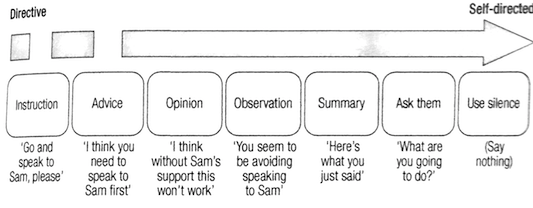
Scale of Influence: Brilliant Coaching, Julie Starr
In a Coaching conversation we may use different levels of influence but we want a good coaching conversation to be more self-directed (left of hand side of the model). In particular Julie recommends that new coaches should try to avoid giving advice or instruction at all.
I’ve recently started using this model to reflect upon the conversations I have with people around me. It has helped to identify times where I could have taken a less directive approach.
As many of my blog readers are Testers I’ve translated what the model might look like in Testing context. For example a conversation between a Tester and a Developer on deciding how to test a particular User Story.

This is a good way to reflect upon the conversations you have with people and understand “Are you really Coaching?”
Next time you are engaging in a Coaching conversation use this model and reflect:
A common question i get asked is “What Coaching books do you recommend?”
Here is a short list of some Coaching Books i’ve read and some that are on my reading backlog.
1. Coaching for Performance: Growing People, Performance and Purpose

What i liked?
Recommended for: Anyone new to Coaching
2. The Coach’s Casebook: Mastering the Twelve Traits that Trap Us
 What i liked?
What i liked?
Recommended for: Scrum Masters (Co-Author Geoff Watts also Authored Scrum Mastery)
3. Time to Think: Listening to ignite the human mind
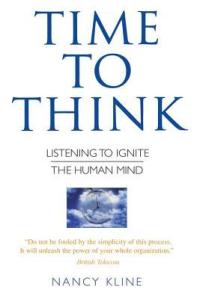
What i liked?
Recommended for: People involved in organisational change
4. Coaching Habit: Say less, Ask more & Change the way you lead
 What i liked?
What i liked?
Recommended for: Managers
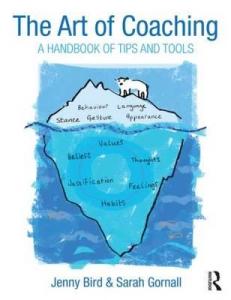
What i liked?
Recommended for: Experienced Coaches looking for new ways to engage clients
Some more books on the backlog:
One of the best talks at XP2016 was from Katherine Kirk @kkirk. If you happen to be at a conference where she is speaking make sure you attend!! Katherine was one of the most engaging and entertaining speakers I’ve seen for a long time.
In Katherine’s talk she introduced us to the concept of Insight Facilitation. Katherine talked about the importance of enabling people to figure out their own solutions in complex adaptive situations. Often “Agile Coaching” is about Process Education. This might appear to have some early success but once the big problems happen the teams are unable to adapt to the changing world around them. Through Insight Facilitation we want to empower people to handle these situations on their own.
As Coaches we can often fall into dysfunctions which can be damaging for the people within our organisations. Katherine talked about 3 common dysfunctions:
These dysfunctions can lead to the following problems:

Taking a Coaching approach can lead to interesting reactions from people. Katherine gave an example of an executive who joined a new company and during the early months people would come to his office asking for advice on how to solve problems, his response: “What do you think you need to do?” The simple act of asking this question was promoting empowerment of the individual and ownership.
This example made me think of a book I’ve been reading recently which is all about asking powerful questions; “The Coaching Habit: Say less , Ask More & Change the way you lead forever“. In particular the book talks about the‘AWE’ question which is incredibly powerful to help explore other possibilities. AWE = And What Else?
Katherine also shared the different reactions she has seen and the journey people take through Coaching which I thought summed it nicely:
Excellent talk and great learning points about Coaching.
Thank You Katherine!
Some of my other posts from XP2016 are here:
At XP2016 there was a panel discussion focused around the “Test Automation Pyramid”

The discussion was facilitated using the “Fish Bowl” technique. The starting panel was:
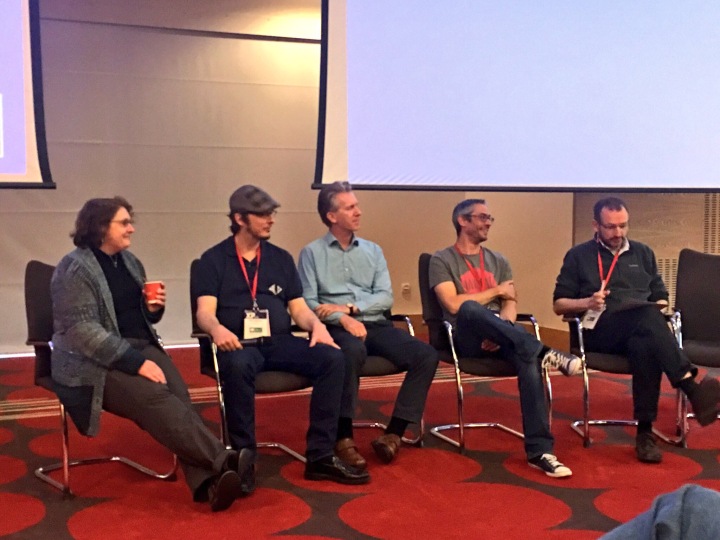
Left to Right: Elisabeth Hendrickson, John Fergusson Smart, David Evans, Simon Brown, Steve Freeman
The discussion kicked off with the following are questions:
The 90 minute discussion covered the following:

Thats me ^
So….what do you think? Leave a comment below.
A few months ago i came across Matt Wynne’s post about Example Mapping on the cucumber blog. During XP2016 I attended Matt’s Example Mapping workshop. I’ve been using the technique with teams for a few months now. This post will share what Example Mapping is and some of the experiences i’ve had using it.

Here is the process taken from the Cucumber blog:
Example Mapping uses a pack of 4-coloured index cards and some pens to capture these different types of information as the conversation unfolds. As we talk, we capture them on index cards, and arrange them in a map:
We start by writing the story under discussion on a yellow card and placing it at the top of the table.
Next we write each of the acceptance criteria, or rules that we already know, on a blue card and placing those across the table beneath the yellow story card.
For each rule, we may need one or more examples to illustrate it. We write those on a green card and place them under the relevant rule.
As we discuss these examples, we may uncover questions that nobody in the room can answer. We capture those on a red card and move on with the conversation.
We keep going until the group is satisfied that the scope of the story is clear, or we run out of time.
And that’s it. I told you it was simple!
Teams I work with follow a simple principle called “Three Amigos”

We apply this to our story conversations ensuring that in each conversation we have:
Usually that results in 3 people but it could be more. We want enough people to have a good conversation.
Our Three Amigo conversations happen in two ways:
It is during these Three Amigo Comversations that we use Example Mapping.
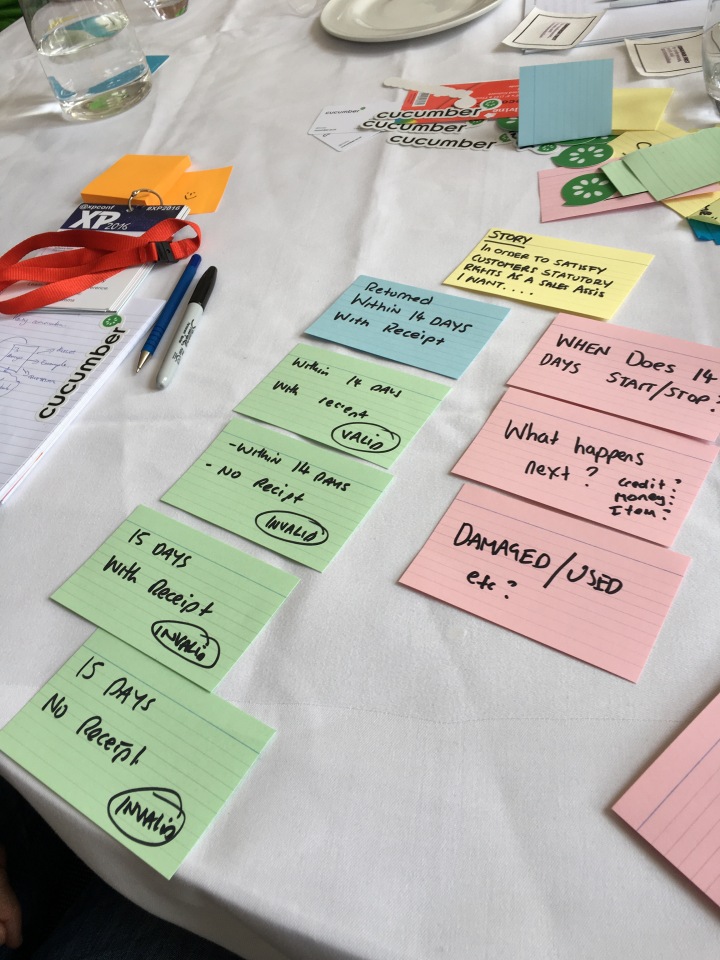
Benefit #1 – Getting past the first Question
Often during Three Amigo conversations i’ve found that teams struggle to get past the first question. When a difficult question arises the team get stuck on that one question. To overcome this we use the Diverge/Merge/Converge technique with Example Mapping. This allows us to get all our current understanding on the table first. We structure the conversation as follows:
Benefit #2 – Colour Heuristics
As the different elements are colour coded it is very easy to use this as a heuristic for the readiness of the story. For example:
Benefit #3 – Knowledge Capture
Often in less structured Three Amigo sessions you can have really good conversations but there is a risk that the knowledge is not captured. In this process you have those great questions and examples captured.
Benefit #4 – Rules not Specifications
I’ve often seen teams write their acceptance criteria as designs or technical specifications. Example Mapping reinforces Acceptance Criteria as Rules. This leads to better examples and ultimately better stories. I’ve seen this be a particular challenge for some teams. If the Acceptance Criteria is written as Specifications its much harder to find good examples which aren’t tied to the technical implementation. Ultimately this process helps you get much better Acceptance Criteria.
Benefit #5 – It’s fast!
Prior to implementing Example Mapping for our Three Amigo conversations our sessions used to be an Hour long. We have now reduced the sessions to 30minutes but run them more frequently. The team finds short, frequent sessions better than longer less frequent discussions.
Benefit #6 – It supports remote teams
We have run the example mapping session digitally. Sometimes we have team members who are out of the office so we use a virtual post it note board.
Benefit #7 – Example format
Sometimes people get lost in the syntax of Examples. Given/When/Then can force people into a certain thought process. This approach allows people to declare their examples in a simple way.
It is also important to socialise your conversations. As Three Amigos is a subset of the team it’s important to share any key findings with the rest of the group. A good way to do this is to post your example Mapping sessions on the wall next to the Scrum Board. This way the team can keep track of the conversations. If you have a remote time simply sharing the link to the virtual whiteboard is a good way.
Typically we want to make the decision – Is this story ready? The main driver we’ve found is Questions. Do we have outstanding questions that mean we cannot proceed. It’s fine to have some questions open if you are confident they won’t impact your ability to proceed in the Sprint. To aid this process a simple Roman vote can help the group decide if the story is ready.
For more about Example Mapping head to the Cucumber blog here
Some notes from the opening Keynote at XP2016 from Elisabeth Hendrickson.
Pairing is really important. Do it as part of your recruitment.
Scaling problems are highlighted in the analogy “Tragedy of the Commons”
“Without intervention work rolls down hill!” Sometimes teams need to help and guidance.
“Don’t do it for me, do it WITH me”
If Field engineers encounter problems they are encouraged to pair with the team to get it resolved. Pair all the time with everyone!
Excellent Keynote!
I will be blogging throughout the conference. You can check out my previous post about Dan North’s workshop here


Today I attended Dan North’s @tastapod Workshop “Software Faster” at XP2016.
Here are a few things I learnt:
Learning #1
What is the goal of agile? Predictability
Learning #2
5 Steps in an Organisatonal Change journey:

Typically alot of Agile Transformations focus on stages 1 and 2. They struggle to move to stages 3, 4 & 5. Often there is a conflict between people at each stage. In many cases stages 3, 4 & 5 are controlled by the “Frozen Middle”; Middle Management. Real breakthroughs only occur once issues are tackled at the later stages. Dans tip to change these stages is to “Use the system to change the system”
More: https://www.amazon.co.uk/Agile-Adoption-Patterns-Roadmap-Organizational/dp/0321514521
Learning #3
Marginal Gains will focus on optimising the existing system. For example if we focus on a 10% improvement we won’t rip up the rule book. For example, people might just starting working longer hours or doing over time. However if we focus on a 50% or higher improvement it will often make us think more fundamentally about our currently processes.
Learning #4
The point of Agile is not to create Software, it is a tool to deliver business capability.
Learning #5
The Goal of software is to:
“Minimise lead time to Business Impact.”
Lead time defined as:
“Having a need to having a need met”
It is easy to improve Lead time once or twice in isolation but it’s really hard to increase lead time “Sustainably”
When does the lead time clock start? As soon as you make a commitment to the person who requested it.
Can you measure lead time if you cannot measure business impact? No.
The big challenge is that measuring business impact is hard! Often teams use proxies such as Story Points rather than genuine impact: Number of users, Profit etc.
If you just focus on Lead Time it will lead to local optimisations.
More: https://dannorth.net/2013/07/05/are-we-nearly-there-yet/
Learning #6
Definition of a stakeholder: “People who’s lives you touch”
Learning #7
A good facilitation technique is to use the analogy of travelling between islands to explain the days agenda.
“Today we will start on Organisation Island, the swim across to Legacy Land, then drive to Core City and finish at the Planning Plateau.”
Learning #8
Three Ages Model can be used to explore where an organisation is:
Age 1 = Explore
Age 2 = Stabalise
Age 3 = Commoditisation

Often Organizations will misuse the ages. For example: try to commoditise testing by offshoring when it is an inherently exploratory activity.
More: https://www.slideshare.net/mobile/AdrianTreacy/dan-north-embracinguncertaintyv3
Leaning #9
PARC Model

More: https://www.amazon.co.uk/Modern-Firm-Organizational-Performance-Management/dp/0198293755
Learning #10
Apply “training from the back of the room” Encourage the attendees to teach each other. Example: In the next 3 minutes put together a pitch to explain what the PARC model is. At the end you will present this to another group”
Here is a group teaching each other:

More: https://www.amazon.co.uk/dp/0787996629/ref=cm_sw_r_cp_api_rshrxbDSR808Y
Learning #11
Value Stream Mapping Tips:
“Become less efficient to improve flow. Introduce sub optimisation.”
More: https://www.amazon.co.uk/dp/1935401009/ref=cm_sw_r_cp_api_6HhrxbNF4G6C6
Learning #12
Focus on reduction of Value at Risk(VAR) by working incrementally.
More: https://en.m.wikipedia.org/wiki/Value_at_risk
Learning #13
Dan finished the session playing a game called Taboo. Each person had to create a taboo card and then we played the game in groups.
This was an excellent way to reinforce the learning. Also another great example of “Training from the back of the room”
More: https://en.m.wikipedia.org/wiki/Taboo_(game)
Thanks Dan for a great day. Now onto post workshop drinks!